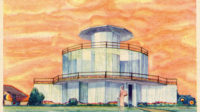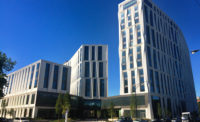New Views into an Unheralded Element of Mies
A new exhibit at the Elmhurst Art Museum explores the architect’s foray into pre-fabrication.

The McCormick House
Photo courtesy of Hedrich Blessing Archive, Chicago Historical Society

The McCormick House interior
Photo courtesy of Hedrich Blessing Archive, Chicago Historical Society

The McCormick House’s current exterior at the Elmhurst Art Museum.
Photo courtesy Elmhurst Art Museum

"Installation View “Glass Houses,” at Lina Bo Bardi's Casa de Vidro (Glass House)."
Photo © Marina D'imperio

Rendering of Seeing Red, an architectural intervention by Iñigo Manglano-Ovalle.
Photo courtesy Elmhurst Art Museum





Architects & Firms
A new exhibit at the Elmhurst Art Museum in Illinois explores a little-studied corner of Mies van der Rohe’s career: his brief fascination with pre-fabrication. The show, curated by Columbia University’s Barry Bergdoll, is physically and thematically anchored by Mies’ McCormick House, which was built in 1952 as a prototype for mass-produced modular homes. Located on the museum’s grounds in suburban Chicago since 1994, the house is now reopened following the first part of a multi-phase restoration project. Titled Mies’s McCormick House Revealed: New Views, the exhibition includes drawings on loan from MoMA’s collection, as well as works from a cast of local and international contemporary photographers. Its intent, says museum executive director John McKinnon, is to “contextualize the McCormick House, which has not been entered into the canon.”
A product of Mies’s collaboration with developer Herbert Greenwald, the house is composed of two pre-fabricated single-story pavilion-like volumes that slide past each other with bays subdivided by gleaming white I-beams and glass. After the structure was moved half a mile from its original location to the museum campus, it was connected to the main building via a hallway that plugged into a former carport. But the connection made it difficult to tell exactly where the old house began and the museum ended. With the removal of this corridor and the restoration of the carport (directed by Heritage Architecture Studio), the museum has gained a more generous plaza, and “liberated” the house, says Bergdoll.
For the McCormick project, Mies used the same structural system and components employed at his 860-880 Lake Shore Drive high-rise. Mies' grandson Dirk Lohan, who attended the opening reception earlier this month, says that his grandfather and his client Robert McCormick “must have had a couple of martinis,” prompting them to pose the question: “Why couldn’t we take one floor of [860-880] and put it on the ground, and develop a house design, just [as] the curtain wall of the [high-rise] was made in a factory and hung in place?”
At that time, there was widespread interest in pre-fab, both commercially and philosophically, as Modernist architects found the dream of machine-made architecture to be an undying obsession. Many, including Walter Gropius, patterned their pre-fab prescriptions for wood, but Mies chose steel. Only two of his pre-fab homes were ever built. “This is a very short-lived experiment in Mies’s career,” says Bergdoll of the exhibit’s scope.
New Views, which occupies both the main museum building and the house itself, begins with a succinct explanation of the McCormick House, then steadily diffuses. In the first gallery, drawings from MoMA’s collection are shown for the first time. The next section puts the house in the context of Mies’s overall career and post-war fascination with pre-fab.
A sub-exhibit, Glass Houses, curated by Columbia’s Renato Anelli, is nestled within one of the galleries, featuring models and scaled-down façade assemblies that offer intimate peeks into glass’s subtle magic of de-materialization. In addition to the Farnsworth House, Lina bo Bardi’s Glass House, the Eames House, and Philip Johnson’s Glass House are also included here.
The exhibit’s final section is its strongest. In it, four contemporary photographers (who previously exhibited this work at the 2017 Chicago Architecture Biennial) interrogate Mies’ use of glass and come away as entranced with the material as he was. With both monk-like patience and an eye for fleeting visual echoes, glass becomes all things. For Luisa Lambri, it’s an hourglass measuring subtle changes in light across space, and for Scott Fortino and Veronika Kellndorfer it’s a mirror, creating otherworldly transpositions of foreground and background.
In a disappointing contrast, Iñigo Manglano-Ovalle’s installation “Untitled Film (Red)” casts the McCormick House interior in a monolithic red glare (recognizable as the terminal stages of 2001: A Space Odyssey) by placing a colored film over its floor-to-ceiling windows, riffing on mid-century marketing materials suggesting that buyers could tint their windows however they chose—a way, McKinnon suspects, to customize an otherwise pro-forma product. But if the purpose of this exhibition is to prove that Mies could adapt new technology to create pleasant and useful homes well-suited to their users, that purpose isn’t served by casting everything in the deadening red haze of a flashing alarm at the moment the outline of the house re-emerges. Some Barcelona Chairs and period furniture, quite simply, would have been a better welcome.
And the museum may well do this, but any installation inside the house will be temporary. McKinnon wants to see different artists interpret the Mies house. “It’s a living, breathing contemporary art museum,” says McKinnon. “We cannot give it the velvet rope treatment and let the furniture collect dust.”
Elmhurst has surely earned the right to be custodians of Mies’s pre-fab legacy. While they’ve smartly contextualized this departure in Mies’s career, for this reputation to stick, they’ll have to prove they can deploy the McCormick House as a unique gallery space with recognizable residential origins.








